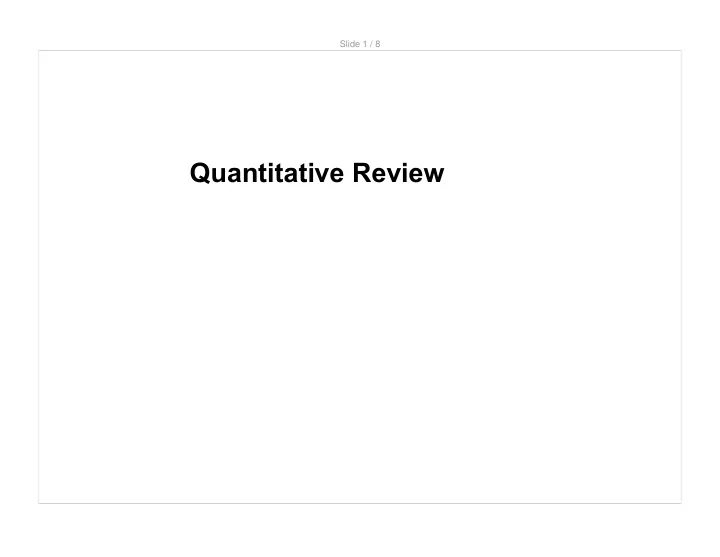

Slide 1 / 8 Quantitative Review
Slide 2 / 8 Questions #1-2 refer to the following graph of logistic population growth:
Slide 3 / 8 1 At what value on the y-axis does the population reach its carrying capacity? Answer
Slide 3 (Answer) / 8 1 At what value on the y-axis does the population reach its carrying capacity? Answer 1 [This object is a pull tab]
Slide 4 / 8 2 At the carrying capacity, the growth rate of the population approaches what value? Answer
Slide 4 (Answer) / 8 2 At the carrying capacity, the growth rate of the population approaches what value? Answer 0 [This object is a pull tab]
Slide 5 / 8 3 In a basic food chain for a meadow community, flowers are consumed by herbivorous insects. Herbivorous insects are consumed by rodents who are, in turn, consumed by a variety of predators. If the biomass of flowers is 10,000 kg, what is the approximate biomass of the secondary consumers? Answer
Slide 5 (Answer) / 8 3 In a basic food chain for a meadow community, flowers are consumed by herbivorous insects. Herbivorous insects are consumed by rodents who are, in turn, consumed by a variety of predators. If the biomass of flowers is 10,000 kg, what is the approximate biomass of the secondary consumers? Answer 100 kg [This object is a pull tab]
Slide 6 / 8 4 Each trophic level in a food chain is only able to assimilate a certain amount of the energy available to them into growth. If 1,000,000 J of sunlight in a valley results in 10,000 J of energy stored in primary producers, what is the production efficiency of the primary producers? Answer
Slide 6 (Answer) / 8 4 Each trophic level in a food chain is only able to assimilate a certain amount of the energy available to them into growth. If 1,000,000 J of sunlight in a valley results in 10,000 J of energy stored in primary producers, what is the production efficiency of the primary producers? Answer 1% [This object is a pull tab]
Slide 7 / 8 5 Production efficiency varies by organism. Birds have a production efficiency of about 1% while fish are more efficient at 10%. Insects have even higher production efficiencies at 40%. If 200 J of energy are available to a grasshopper, how much of that energy will the grasshopper not be able to Answer assimilate into new growth?
Slide 7 (Answer) / 8 5 Production efficiency varies by organism. Birds have a production efficiency of about 1% while fish are more efficient at 10%. Insects have even higher production efficiencies at 40%. If 200 J of energy are available to a grasshopper, how much of that energy will the grasshopper not be able to Answer assimilate into new growth? 120 J [This object is a pull tab]
Slide 8 / 8 6 The basic equation for exponential growth is N = N 0 e rt Where N 0 is the starting population, r is the rate of growth, and t is time. A population of buffalo in Kruger National Park numbered 29,359 in 1991. After this census was complete, a severe drought affected the region. By 1995, the population had dropped to 14,123. Answer The following two years brought ample rainfall that allowed the buffalo population to begin recovery. If the growth rate of the population between 1995 and 2006 was 0.078, what was the population in 2006? Write your answer with two significant digits.
Slide 8 (Answer) / 8 6 The basic equation for exponential growth is N = N 0 e rt Where N 0 is the starting population, r is the rate of growth, and t is time. A population of buffalo in Kruger National Park numbered 29,359 in 1991. After this census was complete, a severe drought affected the region. By 1995, the population had dropped to 14,123. The following two years brought ample rainfall Answer 3.3 x 10 4 buffalo that allowed the buffalo population to begin recovery. If the growth rate of the population between 1995 and 2006 was 0.078, what was the population in 2006? Write your answer with two significant digits. [This object is a pull tab]
Recommend
More recommend